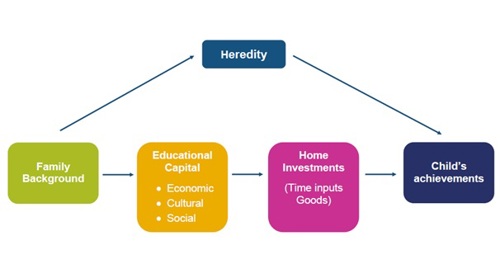Schools that work for everyone: What is disadvantage?
Thursday 8 December 2016
Monday is the last day for responding to the government’s “Schools that work for everyone” consultation – one of the most intensely debated in recent times, particularly for its proposed expansion of grammar schools.
One of the objectives stated by the Department for Education (DfE) is to ensure that good school places are available to children of disadvantaged families, and not just those who can afford them by moving into the right catchment area, paying for private education or tuition, or belonging to a given faith group.
In this blog series, I’m going to explore some important questions that will need to be considered by the government in order to meet their aims: What do we mean by disadvantage, how can we measure it, and what does this imply for policy?
Disadvantage in a school context
A theoretical framework that has been widely used in educational research for the past two decades is the intergenerational persistence model. It draws mainly on the work of economists Robert Haveman and Barbara Wolfe and the concepts of cultural and educational capitals articulated by the French philosopher, anthropologist, and sociologist Pierre Bourdieu.
According to the intergenerational persistence model, children’s achievement is assumed to have two determinant factors: heredity and home investment.
Heredity refers to innate traits and attributes that a child inherits from his/her parents, and home investment refers to time and a series of “goods” that a family needs to provide to ensure that the child will do well in school.
“Goods” can be concrete (books, a school kit or a healthy packed lunch); services (such as paid tuition or joining an after school club); or intangible (e.g. providing the child with an extensive vocabulary or the confidence to speak in public and answer a teacher’s question). In particular, quality schooling can be considered both an essential and a premium “good”, and one which requires a considerable investment for many families.
In the same way that each family or household has a certain level of income that allows its members to afford the goods and services necessary to their daily lives, families with school age children possess “educational capital” that allows them to provide a child with what’s necessary to do well at school. Similarly, we can think of poverty/disadvantage in the school context as the lack of sufficient educational capital to afford the necessary “goods”.
Economic, Social and Cultural Capitals
The intergenerational persistence framework is illustrated below. It shows that “educational capital” is the combination of three different types of capital: economic, cultural and social.
Economic capital (a family’s income) is an important component of overall educational capital. The links between poverty and a child’s educational outcomes are universally acknowledged and a target of policy for many governments. However, it is only part of the picture: economic capital is not equivalent to educational capital.
In the same way that a family or a household may have several sources of income, the other two forms of capital, cultural and social, also contribute to overall educational capital.

Cultural capital, as defined by Bourdieu, refers to “non-financial social assets that promote social mobility beyond economic means”. In particular, he stresses the importance of familiarity with the dominant culture in a society and the ability to understand and manipulate “educated” language and concepts. In a school context, cultural capital includes parents’ education, occupation, knowledge, and the cultural ‘consumption’ and practices within the household.
Parents’ education has been shown to be a more powerful predictor of children’s educational attainment than household income alone. Cultural capital should hence not be dismissed as secondary to economic capital. Besides the fact that better educated parents are better equipped to help children with their school work, there is also evidence that parents’ cultural status will have an impact on their children’s outcomes in more subtle ways.
Social capital is defined by the Organisation for Economic Co-operation and Development (OECD) as “networks together with shared norms, values and understandings that facilitate co-operation within or among groups” and relates in the school context to how well family members can relate and interact with each other, the community, and schools.
Families that experience domestic violence; migrant families that experience discrimination or are not familiar with the host-country’s social context; and single-parent families can all be seen as disadvantaged in terms of social capital. On the other hand, families that enjoy a comfortable lifestyle and have strong ties with their local communities will generally benefit socially.
Economic, cultural and social capital are interconnected, and generally the most disadvantaged households are deprived of all three. However, as we move up the educational advantage/disadvantage spectrum a more nuanced picture emerges. For instance, there are children in lower income households who are endowed with substantial resources in terms of social and cultural capital, and also children that although not living in poverty are nevertheless deprived socially or culturally.
Any policy designed to tackle disadvantage in England therefore needs to consider this more complex view of what disadvantage actually is. But in order to do this, we need suitable measures that encompass this wider definition.
This will be the topic for my second post in the series.
